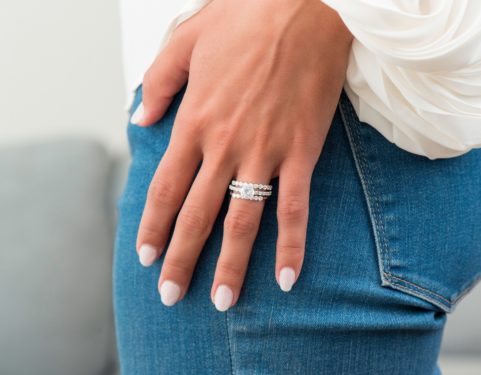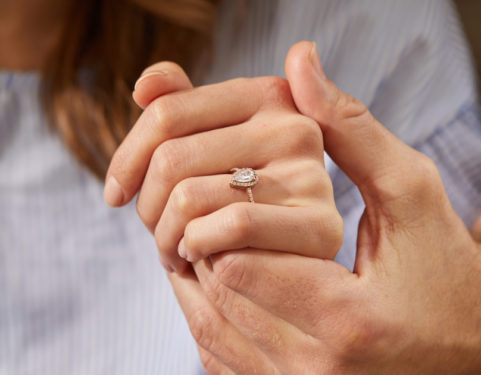Most of us have heard “bigger is better” when it comes to diamond engagement rings. You gotta wonder though–is that really the case? Here we will go into detail about the average engagement ring size.
The average engagement ring size falls between 1-2 carats. It depends on who you ask.
The mega-popular wedding site TheKnot.com ran a survey and came up with 1.5-carat engagement rings being the norm.
The exact carat size varies among different reports. Some say the average diamond size for a ring is 1.08 carats and others say it’s 1.2 carats.
Let’s just say around one carat, shall we?
However, everyone seems to agree with the average diamond weight in total being closer to 2 carats.
The Average Diamond Carat Weight
The average diamond carat size for engagement rings also depends on where you live. In the United States, the national average is just over one carat. According to Brides Magazine, it’s 0.6 carats in the UK and around a half-carat in Europe.
Just because that’s the popular size, doesn’t mean it’s the standard.
Not everyone can cash in on a one-carat diamond ring with the best possible diamond grades. Those babies come at a high price, even if it’s just one carat.
It seems people these days would rather have the highest quality diamond instead of a large rock.
And with good reason.
A center stone with lower diamond grades doesn’t make for a pretty diamond engagement ring. Without an eye-clean and well-cut diamond, you’re stuck with a big and unattractive ring.
Cut Is King

The average carat weight of a diamond engagement ring might be 1.5 carats, but that’s not the biggest concern for most. Diamond-savvy people agree the cut grade of their center stone is the most important factor about their diamond,
They’re not wrong, either.
You want to choose your chosen diamond shape based on the recommended proportions for its shape. Round cut engagement rings cut grades should be ideal cut or Excellent cut grades. Cut quality should come before carat weight any day.
The cut of your diamond engagement ring controls its sparkle and beauty. That’s the main reason people want large diamonds to begin with.
Save Money For Diamond Clarity
If we were you, we’d save more money on a smaller diamond with better clarity. That’s if we had to choose between the average carat weight or high clarity. We’d much rather have both, in all honesty. It’s probably the second most important thing about buying high-quality diamonds.
Some people prefer diamond color to clarity. But there are better workarounds to dealing with color than clarity.
If you’re going above the average engagement ring size, you want a diamond without a lot of inclusions. The flaws in an engagement ring diamond weighing two carats to three carats look bigger than one carat would. You’ll need a higher clarity grade like a VS diamond ring or VVS diamond ring. This post has a diamond clarity chart, it’s a great reference for understanding clarity better.
If you’re buying engagement rings below the average diamond size, it’s not necessary to buy a VVS or flawless diamond.
A Word About Diamond Color

We won’t spend a ton of time talking about diamond color, but we’ll impart some nuggets of knowledge.
There’s a decent price gap between a J color ring and a D color ring. They’re on opposite ends of the spectrum.
Color grades right next to each other don’t appear to make a difference. Many can’t tell the difference between an E and G color sitting side by side. That’s how small the difference is between colorless and near-colorless diamonds.
They’ll also look brighter if you pick a shape with a brilliant cut. Brilliant cut diamond shapes allow more white light to be reflected out.
Nearly all popular shapes are brilliant cut, except for emerald cut diamonds and Asscher cut diamonds.
At just over 1 carat, there’s no need to pay for a colorless diamond. Many people buy at the lower end of near colorless without noticing any tint.
Carat Size vs Carat Weight
Diamond experts say many customers tying the knot aren’t aware of the difference between carat weight and carat size. The two aren’t the same.
Carat size is how big the diamond looks. Carat weight is how much it weighs. The weight of a center diamond is distributed by its shape.
How Diamond Shape Affects the Average Diamond Size

Diamonds are cut differently according to shape. The faceting techniques on a round-cut diamond engagement ring calls for a deeper cut. More of the carat weight lies in the pavilion (bottom) of a round cut diamond.
An emerald-cut diamond engagement ring will have a bigger face-up visual size than a round cut because its carat weight is distributed differently. Emerald cuts are more shallow than round diamond engagement rings.
It’s a fantastic option for those who want to stick to a budget and still get the best value on a large diamond. An emerald cut engagement ring will be less expensive than a round cut ring of the same diamond grades and carat weights.
The diamond shapes with the largest face-up sizes for engagement rings are marquise, emerald cut, and oval-shaped diamonds.
Getting The Best Value on The Average Carat Size

A 1.5-carat engagement ring might be a little out of your budget. You might think you’re stuck buying below the average engagement ring size. Never fear, cost-saving tips are here!
Buying Diamonds Online vs In-Store
One way to save money on the clarity of an engagement ring is to buy diamonds online. Plus, it’s more fun to choose from a pool of loose diamonds and ring settings.
You can also view high-quality images and 360˚ videos of many loose diamonds. These are especially helpful because a lot of people have trouble seeing through a jewelers loupe or microscope. It’s much easier to see it magnified clearly on a screen.
You can chat online with a diamond expert to choose the right carat size and other parameters for your engagement ring. It gives you a lot more control than picking out pre-set engagement rings in-store.
You can design your own engagement rings online without having to pay any of the labor costs to create custom diamond rings at brick and mortar stores.
Buying Lab Created Diamonds Instead Of Mined Diamonds
Lab diamonds come in a bunch of unconventional names: synthetic diamonds, cultured diamonds, man-made diamonds, created diamonds, and lab grown diamonds.
Whatever you want to call them, lab diamonds are real diamonds. They have the same physical, chemical, and optical properties as mined diamonds. They’re real diamonds that were grown in a controlled lab environment instead of in the ground.
Here are three ways to save on the average engagement ring size when you choose lab diamonds instead of natural diamonds.
#1 Works Within Your Budget
The price tag on the average diamond size for engagement rings is less expensive than a natural one. Lab grown engagement rings can be 20% to 40% more affordable than mined engagement rings. You can choose to go bigger for less or have more money to spend on your setting.
It doesn’t cost as much money to produce them and bonus: less energy used. Lab diamonds are better for the environment than mining diamonds. It’d be great if one day all lab diamonds were completely sustainable, but they aren’t yet.
Double bonus: Lab diamonds provide customers peace of mind to know they are buying 100% ethical jewelry.
Buying lab grown can get you the best value on the average ring size. You can even go beyond the national average. We’re talking two or three carats if that’s your style.
#2 Fewer Flaws
You’re also more likely to find a bigger stone with fewer flaws to the naked eye. That’s because lab diamonds don’t have many minerals coming into contact with them while they grow.
The types of inclusions found in lab diamonds tend to be less noticeable. You won’t find many I clarity lab diamonds out there.
#3 Flexible Color Grades
We’ve spent a lot of time comparing apples to apples with lab diamonds and mined diamonds. But one thing we’ve noticed about lab diamonds is there isn’t too much of a cost difference between color grades.
You shouldn’t need to handpick your color grades to suit your budget. Most lab diamonds have higher color grades. It’s not uncommon to see DEF color grades without a big difference in cost.
What If The Average Weight Is Still Out Of Your Budget?

Big sparkly diamonds have always been a status symbol. A lot of that is due to advertising and Hollywood.
Most people today are bypassing the average carat size. Instead, they’re spending more of their budget on engagement ring settings.
Engagement Ring Styles Are Shifting
White gold is still the preferred metal for an engagement ring, but the ring style trends are turning. Gone are the days when everyone wanted a huge diamond set in a solitaire engagement ring setting. Styles are more varied now.
Brides Magazine’s survey said that more are choosing center stones below the average size and having lots of smaller stones in the ring setting. Some people are also opting for two stone engagement rings, featuring two center stones instead of just one. Many choose diamond shapes with a bigger visual size for their engagement ring.
Conclusion
The average diamond size for an engagement ring may be around one carat, but no written rule says you have to have it. The right diamond size for engagement rings is in the eyes of the beholder.
If the average carat size for an engagement ring is within your budget, go for it. Just make sure to give your other diamond grades more attention first.
But if a 1-1.5 carat diamond is out of your budget, don’t sweat it.
True beauty comes in all sizes, and an engagement ring is no exception.



